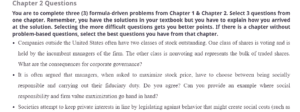Chapter 2 Questions
Companies outside the United States often have two classes of stock outstanding. One class of shares is voting and is held by the incumbent managers of the firm. The other class is nonvoting and represents the bulk of traded shares. What are the consequences of corporate governance?
Holding two classes of outstanding stock enables the managers to retain control of the firm by preserving their voting rights. This control negatively implicates corporate governance, which vouches for fairness and integrity in the firm’s operations. Effective corporate governance may not be achieved by dual stock ownership. The reason is that the shareholders are left out of decision-making yet invest their wealth. Investors’ primary objective is wealth maximization, attained through earning maximum returns from the invested stock. The firm’s financial performance determines the gains, which are subjected to the managers’ decisions. The decisions that include capital budgeting, financing, and dividend policy directly affect shareholder returns (Damodaran, 2010). Capital budgeting involves investing in large-scale projects that require a considerable capital outlay. These projects yield returns over a significant period. Poor decision-making in capital budgeting would lead to losses by the firm, and investors would not earn profit from their stock. The dividend policy determines the number of profits to pay out to shares. This policy could be unfavorable to the shareholders. Unfortunately, even when managers make poor decisions, shareholders are powerless since they have no control over decision-making. Thus, even when the managers misbehave, the shareholder can’t remove them by voting them out. Hence this form of stock ownership is unsuitable for enhancing corporate governance in a firm.
Do you need an initial version of “Chapter 2 Questions accounting help”? Contact us.
When asked to maximize stock price, it is often argued that managers have to choose between being socially responsible and carrying out their fiduciary duty. Do you agree? Can you provide an example where social responsibility and firm value maximization go hand in hand?
There are credible approaches to profit maximization that ensure that managers are socially responsible. Hence managers can still undertake their fiduciary duty of maximizing the value of the stock price while maintaining social responsibility at the same time. One of the key drivers of the stock price is a firm’s earnings; thus, to maximize the value of the stock, managers could implement strategies and processes that result in optimal earnings for the firm. The high profits attract investors, driving the stock’s value (Damodaran, 2010). These earnings are indicated in the financial statements released by the firm to the public. Thus, when shareholders invest in the shares of such a firm, they purchase the stock’s actual value, unlike when the managers overvalue the company’s stock by falsifying earnings in the financial reports, which misleads investors.
Societies attempt to keep private interests in line by legislating against behavior that might create social costs (such as polluting the water). If the legislation is comprehensive enough, does the problem of social costs cease to exist? Why or why not?
Comprehensive legislation against corporate behaviors that results in social costs could effectively reduce these expenditures. Heavy penalties against firms that are non-compliant with the enacted law are a pragmatic approach to reducing social costs because the firm’s primary objective is wealth maximization (Damodaran, 2010). The latter is achieved through maximizing profits and minimizing costs. The penalties rendered against a firm would increase the costs incurred by the firm, thus leading to a reduction in the firm’s profitability. Therefore, the firm would avoid such penalties in undertaking its operations at all costs. As a result, the companies would adhere to the set legislations designed to shape these firms’ behaviors in minimizing social costs. The legislation would be helpful since firms do not include social fees in their budgeting to maximize profits because it increases the damage incurred. For instance, implementing strategies that reduce pollution would lead to additional charges to the firm, making organizations avoid such initiatives. Hence, legislation is the best approach to enforcing practices that minimize social costs.
Similar Post: Create a Budget and Financial Plan for a Vacation Trip
References
Damodaran, A. (2010). Applied corporate finance. John Wiley & Sons.
ORDER A PLAGIARISM-FREE PAPER HERE
We’ll write everything from scratch
Question
Chapter 2 Questions
You are to complete three (3) formula-driven problems from Chapter 1 & Chapter 2. Select three questions from one chapter. Remember, you have the solutions in your textbook, but k but must explain how you arrived at the answer.

Chapter 2 Questions
Selecting the more difficult questions gets you better points. If there is a chapter without problem-based questions, choose the best questions you have from that chapter.
- Companies outside the United States often have two classes of stock outstanding. One class of shares is voting and is held by the incumbent managers of the firm. The other class is nonvoting and represents the bulk of traded shares. What are the consequences of corporate governance? When asked to maximize stock price, it is often argued that managers have to choose between being socially responsible and carrying out their fiduciary duty. Do you agree? Can you provide an example where social responsibility and firm value maximization go hand in hand?
- Societies attempt to keep private interests in line by legislating against behavior that might create social costs (such as polluting the water). If the legislation is comprehensive enough, does the problem of social costs cease to exist? Why or why not?
Textbook:
Applied corporate finance / Aswath Damodaran. – Fourth edition. ISBN 978-1-118-80893-1

